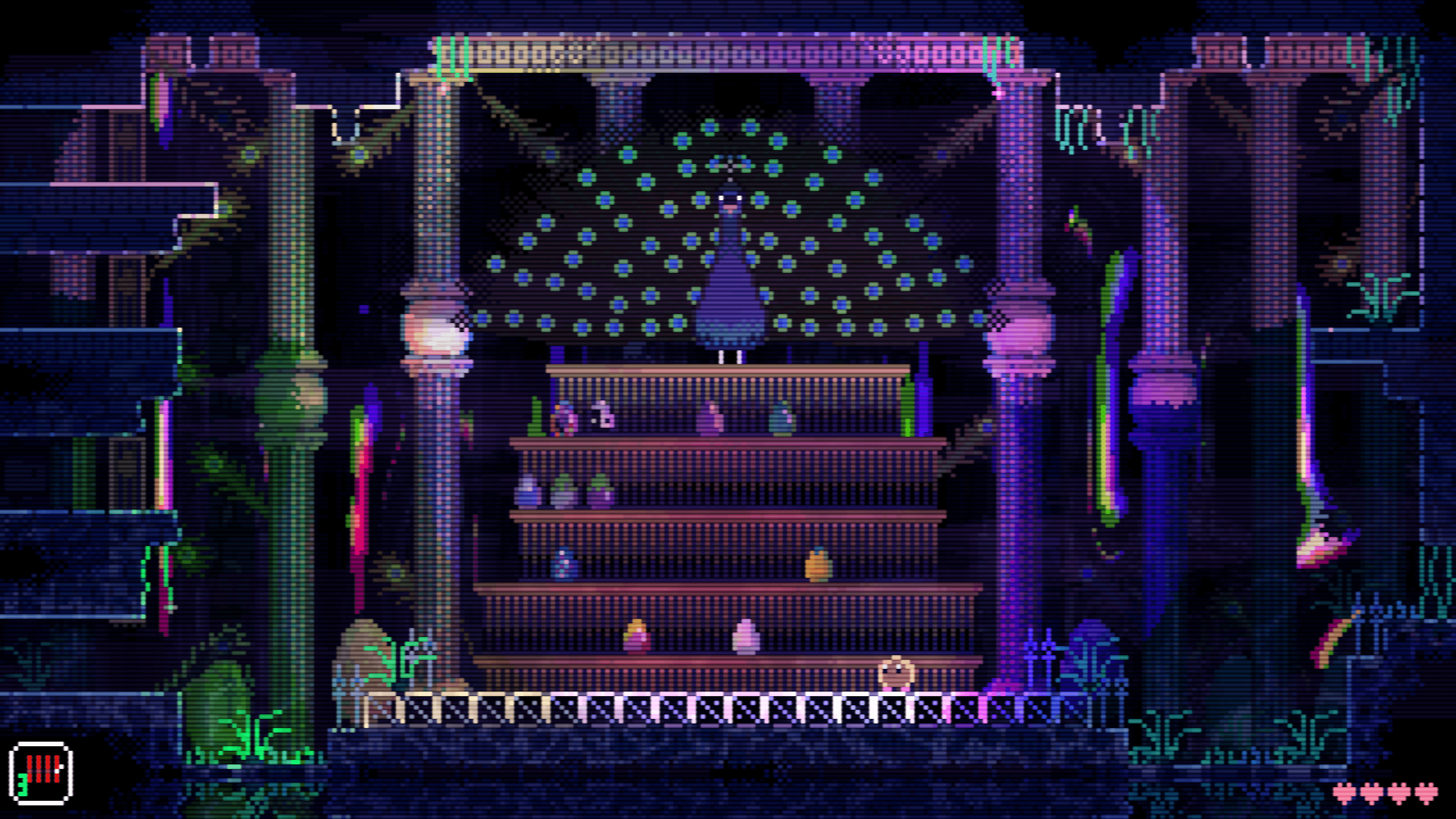It’s been a while since I last covered a show in person. PAX West 2019 was the last time I did that. Feels like a lifetime ago. I’d more or less accepted that was something of the past given the ways Covid continues to be a ever-present threat that the world has decided to ignore, but an opportunity to attend PAX West this year came up and, well… took my shot.
It was a good reminder of how much I missed doing this.
Seeing new games and chatting with their creators was always one of the highlights of traveling to these events. For as difficult and exhausting working these shows is, those moments always make it worthwhile. It’s the people who always make these shows memorable, that make the hard work worth enduring. Seeing some cool games is just a bonus — and boy were there a lot of games.
Here’s everything I saw at the show.

Biomorph
Biomorph is a metroidvania where you transform into the creatures you fight and use their abilities to explore and aid you in combat. Right off the bat it feels good. Movement is very fluid and attacks can chain together effortlessly, making even the most basic attack strings satisfying. The demo only gave me a punch and a blaster to play with, but as far as basic toolsets go, it’s very effective.
Where Biomorph stands out is how it handles its sort of adaptive difficulty. By morphing into the same creature frequently, they will eventually learn new skills when you encounter them as enemies. The first one I was able to transform into – a large four-legged creature with a large plated head – let me crash through crumbled walls and other barriers I otherwise couldn’t bypass. That charge was all it could do when I fought it. But when I ran into one again later after having morphed into it a few times, it now spit a spread of acid shots instead of just trying to charge at me.
The idea is to help keep fights interesting as you traipse about the world. Metroidvanias traditionally keep enemy placement and behavior static, which makes enemies you encounter along the way more or less moot as you become more familiar with the space and thereby able to bypass fights entirely. Biomorph wants things to be more dynamic, to make the backtracking more treacherous, and to add consideration to which forms you want to use and the consequences of doing so. Given how good combat feels, I hope the evolving enemy behaviors will actually make engaging in fights exciting throughout.

Arzette: The Jewel of Faramore
If you ever wanted a new game in the style of the CD-i Zelda games, Arzette: The Jewel of Faramore is for you. It captures the specific style and vibe of those games perfectly. That’s in no small part thanks to getting a lot of the same people who worked on those games to contribute to Arzette. Artists and voice actors alike were on board to make something new, largely because Arzette was born out of a sincere appreciation for those games.
Seth Fulkerson, the lead developer, said he always saw a lot of potential in those games and thought it would be a fun challenge to put his own spin on it. He’s previously worked on fan-made remasters of those games as well (“I played through them and basically had to reverse engineer a design document for each one, and then just go through the design process in GameMaker,” Fulkerson told me), which no doubt helped a ton in making sure Arzette captured the feel of those games.
It’s a pretty straightforward platformer in terms of play. Your sword is the main means by which you interact with the world (just strike whatever you want to use or whoever you want to speak to). Items such as bombs can be used to clear enemies quickly or saved to open hidden areas. I found one spot I could have blown up to uncover some kind of secret (there were very pronounced cracks on the surface), but I had already used all my bombs earlier because I didn’t think about that possibility.
It’s very charming. For as much as the Zelda CD-i games are derided, seeing that style adapted into something original, divorced from the baggage those games have been assigned in the greater videogame canon, makes it easier to take it on its own merits and appreciate. Would be fun to see if this ends up inspiring more people to make games that riff on the CD-i because, despite the (earned) poor reputation it has, there are some cool games there.

Dragon is Dead
What if Diablo was a side-scrolling roguelike? That’s Dragon is Dead. Okay, there’s more to it than that, but it’s very much a game that wears its influences proudly. It’s a side-scrolling action game with roguelike elements. You choose one of five characters, each representing a different class. Only one was playable in the demo I got — a melee focused class wielding a large sword that seemed built around dealing heavy damage.
The bit I played felt like standard side-scrolling action fare. It felt snappy. The main thing that tripped me up was how the dodge roll had a cooldown. An intentional choice, clearly, to control how aggressive you can be, but one that still caught me by surprise every time. All skills are shown on a hotbar on the bottom of the screen and are mapped to different buttons. I didn’t get to see the roguelike elements manifest firsthand, but I’m told the hook here is how items you find carry over between runs. By doing so, the idea is to allow players to get back up and running on a new run quickly, which sounds pretty good given the nature of the game otherwise.

ZOE Begone!
ZOE Begone might be the first side-scrolling shooter since Graceful Explosion Machine that I can easily see myself losing a bunch of hours to. It’s a hand-drawn arcade-style shooter where you’re moving back and forth along a film strip fighting against an animator and the various creatures they draw. It’s a very cool look and a fun premise.
The core of the game revolves around using your dash to hit multiple enemies at once. Some tend to group together in specific clusters that make it easy to hit them all at once in a single motion, while others might require another dash or two. You only have so much energy, however, so you can’t just dash left and right. Need to be considerate of when to use it. There are items strewn across the bottom of the screen you can use to heal and restore energy, but they don’t respawn, so careful resource management is key. Occasionally you’re able to shop for upgrades, such as the spread of your shots and their properties. Instead of finding those during play, you instead purchase them with apples you collect while fighting through waves of enemies.
It’s a very busy game once you get a few stages in. The screen was full of enemies and bullets alike, turning the field into utter chaos. It was very fun! Had to pull myself away lest I spent the rest of the appointment playing it.
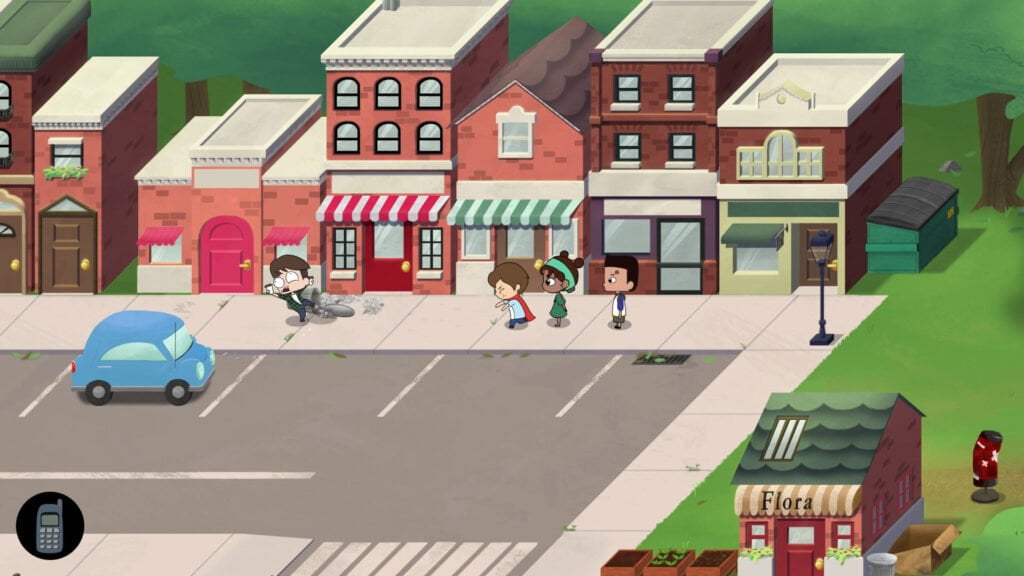
Cricket: Jae’s Really Peculiar Game
Cricket is an RPG inspired by games like Earthbound and the Mario RPGs. Didn’t see too much of the story in the demo because I was pressed for time (demoing RPGs is hard), but the bits I saw were fun.
First thing that happens after leaving the house is the two kids are attacked by some squirrels, which they brush off rather quickly. It serves as a quick tutorial on battle. Cricket’s combat takes some cues from the Mario RPGs in that you can time a button press to increase and reduce damage. Where it differs there is that you can choose to press a different button with a tighter timing window for additional damage on your attacks and negate any damage from the enemy. The game does helpfully provide a visual for when you need to time the input, but it is still a bit tricky at first.
From there, the two head off to town to meet up with someone. They stop by the local florist only to find a robbery had taken place. The culprit? A sentient flower. It tries to hide around town and eventually leads the two kids to where the rest of the flowers are gathering. The flowers are stealing flowers from a florist for… I don’t know. Didn’t get far enough to learn the plan, but Cricket certainly wastes no time in living up to its title with all the peculiar events going on. It’s very charming.

Wild Country
I’m not usually one for card games broadly because I’m just not good at the process of building a deck. What drew me to Wild Country, then, was the pairing of a city builder of sorts. Wild Country’s cards largely act as tiles you place on a board. Most cards are buildings, each with a different property. The goal is to be the first to earn a certain amount of money. Whoever succeeds wins the match.
You go about this by trying to pair certain buildings that have adjacency bonuses to increase your earnings. It becomes a case of balancing how to build with gaining bonuses in mind, but also how to counter your opponent by denying them space. That’s something I learned the hard way because my opponent stole one of my buildings, greatly reducing the amount of coin I was making. I didn’t do particularly well in the two games I played, but I felt like I was getting somewhere as far as understanding the flow of play and strategy layer goes. Might have just needed to adjust the deck to be able to counter my opponent’s aggressive approach.
There’s also a full campaign here. The pitch for the story is that the mayor is retiring and is holding a competition to see who should be the next one. You roam about taking on requests and helping people out (one I took one had me handing out ice cream) and playing against anyone who’s up for a game. The competitive play seems like the draw, but it is nice to have something there for the less competitively inclined (like me).
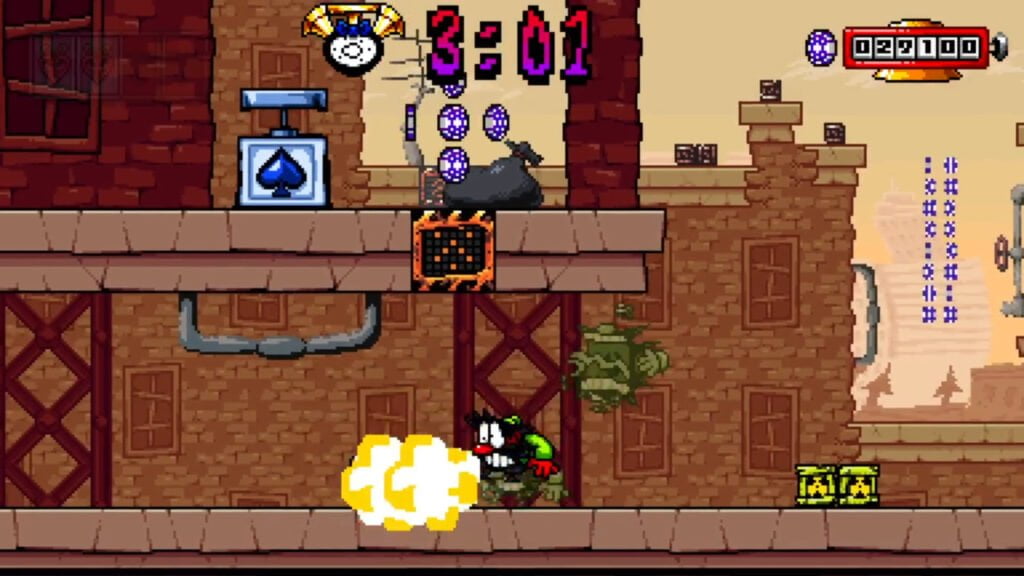
Antonblast
Atonblast is easily the most overwhelming game I played at the show. It’s a platformer inspired by Wario Land, this one emphasizing destruction over speed like Pizza Tower from earlier this year (though Antonblast is still plenty fast). The premise is that Satan has stolen all your booze and Anton, a destruction worker, wants it back and will destroy all of hell if that’s what it takes.
It’s very silly. An energy that carries over into every facet of the game. The expressive, exaggerated animation, the loud and overwhelming effects as you break through blocks and enemies alike, levels falling apart all around you. It’s a lot but in the best way possible.
Every level is long, but that’s in part because you’re going through it forward and backward. The goal is to reach the end of the level and start the demolition process. The first pass through a level is more willing to take it slower. You can take your time and explore, see everything the space has to offer. Checkpoints are common as well, so you’re never far from where you fell. On the second pass, it’s all about moving as fast as possible while everything falls apart around you.
The escape sequences are extremely thrilling. Though I already knew the level, going through it in reverse in one go is tough. I probably could have slowed down a little bit, but the energy of these sequences is such that it’s hard not to just go full-speed ahead. These moments capture what I love about a good platformer, which is when you can just move through a space effortlessly in one smooth motion. Well, maybe not the one smooth motion part (Anton isn’t exactly graceful in his movement), but definitely the effortlessness for sure.

Ebenezer and the Invisible World
I’m sure I’m not alone in being bewildered by this game’s pitch when it was unveiled. A metroidvania based off A Christmas Carole is a bizarre idea, but it’s also something done clearly with a lot of care and reverence for the source material. When I was chatting with one of the developers he spoke with an enthusiasm about the story that only comes from someone who truly, deeply cares.
The broad story pitch is Ebenezer, following the events of the original story, has gained the ability to see and speak with ghosts. The trio of ghosts responsible for making him change his ways attempted to do the same with someone Ebenezer knows, only it failed this time. Instead of seeing the error of his ways he’s decided to double down in an effort to bring about full automation, despite that doing so will kill him, so he can be rid of human labor and hoard all the profits for himself.
As a metroidvania, Ebenezer and the Invisible World feels like it leans a touch more on the Castlevania side of things in terms of feel. It’s mostly due to little things — the backdash and the distance it covers, how summoning ghosts to aid in battle depletes a magic meter; it’s not a one-to-one thing the way Bloodstained was literally just Symphony of the Night again, but the comparisons feel apt all the same.
Movement feels snappy and the combat’s fun. I ended up having to play very carefully because I didn’t have any healing items available, which forced me to really pay attention to enemy movement and attack patterns. Also made the game much harder, obviously, but it wasn’t unpleasant. Forced me to really learn how best to use the ghosts at my side, to approach any and all enemies with caution. Probably not the best representation of what an average session looks like, but it did showcase how good the combat is that I could find some fun in those circumstances rather than give up in annoyance.
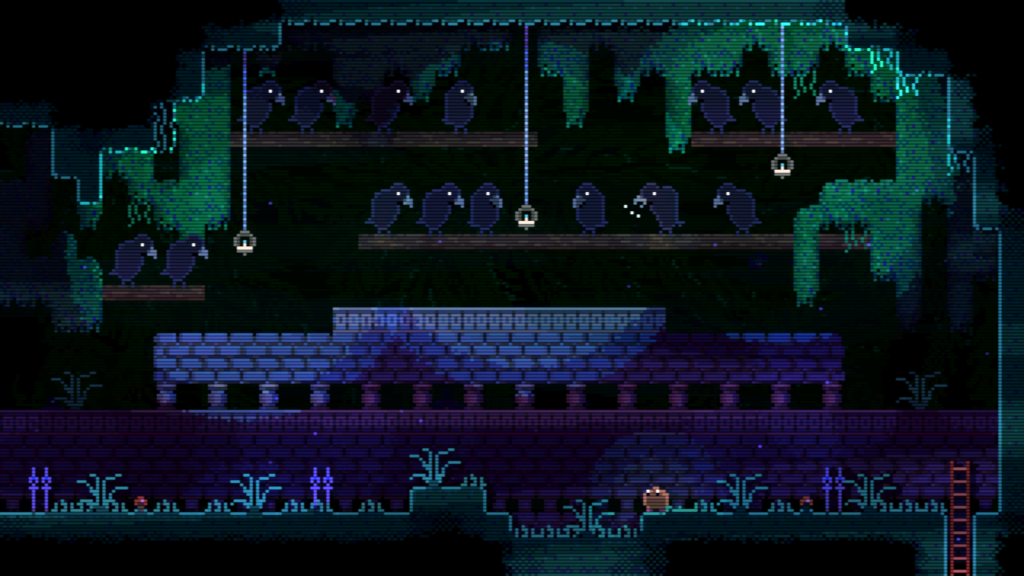
Animal Well
Animal Well is one of those games that’s tough to get a good sense for based on a demo. It’s a game that provides seemingly no guidance. You’re dropped into the world and left to your own devices, left to explore and figure out how to interact with the space. The only verbs I had available were to move and jump. I eventually found some firecrackers I could use to ward off the rare foe as well. But Animal Well seems primarily focused on exploration.
Level design is extremely open, letting you wander freely. Though the demo was brief, the bit I played effectively communicated that the world is huge. I don’t think I saw anyone else move through the same few rooms. We all seemingly ended up in wildly different spots. I kept expecting to run into some obvious gate that suggested I should be moving elsewhere, but I kept being able to move forward, always finding new branches to follow. I’ve no idea what the full game will actually entail, but the fact that it’s so willing to be hands-off and open ended is very exciting.

Another Crab’s Treasure
It’s a souls-like where you play a hermit crab. That’s already a fun pitch as is, but the ways Another Crab’s Treasure takes that idea and runs with it are delightful.
First thing that stood out is that it’s a bit of a platformer. The tutorial area saw me jumping and climbing about it in ways I don’t usually see in souls-likes. Most importantly, it felt great. Platforming isn’t usually this genre’s strong suit outside of the form of 2D side-scrollers, but Another Crab’s Treasure seems to be taking steps to make jumping a worthwhile verb.
Big thing are your shells. Shells have different attributes and varying amounts of durability, requiring constant awareness of where your next shell is so you don’t end up defenseless. They can’t be carried around in your inventory as you can only equip one, so picking one up from the ground is your only option. It’s a clever idea. It makes defense more active since you can swap at will. You can of course dodge attacks as well, but I tried relying on that more than blocking and it, uh… didn’t go well. One of the devs told me I needed to block more, which — yeah. Fair.
It’s a pretty straightforward souls-like, otherwise. Didn’t get a sense for whether the game is more focused on defensive play versus aggression, but it does capture the core tenets of souls-like design. The enemies and the boss I fought felt in line with what I’d expect out of these sorts of games — just with a way more bright and colorful aesthetic.

Inpulse
Inpulse is a game built by fans of the kaizo style of platformer with that crowd in mind. But it’s also one with the intent to make that subset of platformers more approachable, to draw in those who haven’t touched a kaizo game before but are interested in the form.
Kaizo refers to a specific style of platforming that demands a high level of precision and execution. It’s often used to refer to various Mario game ROM hacks (Kaizo Mario being a specific set of games), but it can also apply to some of the more demanding optional levels of games like Celeste or Super Meat Boy. Point is, the games are hard. It’s a mode of play that asks a lot of the player, that’s built on high-speed play and rapid repetition to succeed.
Inpulse is no different. It’s a fast-paced platformer where you need to run and jump with speed and precision. The core mechanic is “shooting.” By shooting in the opposite direction from the one you’re moving, you can give yourself a significant boost in speed and air-time. It took a bit for me to get used to. Boosting by pressing the opposite direction makes sense, but it does add to the mental stack in a way I didn’t expect.
Where Inpulse differs is in how it’s trying to be more approachable. There’s a couple ways it goes about this: one, a ghost that’s constantly running the level so you can see what you need to do, complete with the inputs displayed on the right (which can be shown as a Dance Dance Revolution-style note track if you so desire). The inputs are useful because it demystifies what’s actually happening. Just watching a run through the level does a lot in that regard, but the inputs clarify some of the finer points. Why did they shoot but not get the boost in momentum? Because they jumped right after firing to negate it to avoid getting too much extra air time. Things that probably could be observed, but become easier to pick up on when seeing the actual inputs paired with the actual play.
And two, save states that you can set anytime, anywhere, with no limits. Cross a particularly difficult section? Drop a save state and no longer think about it. It allows levels to be reduced to a set of parts you can focus on individually instead of having to run the entire level again and again until you’ve got it. I’m not sure where you’d drop a save state in some levels (didn’t feel like there was a good spot in a few levels I played – or at least not any that wouldn’t disrupt my flow), but that the option exists at all is a massive boon.

Death of a Wish
Death of a Wish builds off Lucah’s foundation in exciting ways. It is a much more aggressive game, for one, as there’s no longer any stamina meter to restrain you. It’s no longer a souls-like but a pure action game with all that entails. To account for this, some of the core mechanics have changed as well. Enemies now have a “guard meter” that must be depleted to put them in the “break” state. In Lucah, all you needed to do was parry once or land a particularly strong attack to do so. Now you need to parry multiple times to rapidly deplete that meter or slowly whittle it down through regular attacks. Think of it like the posture meter in Sekiro.
A bigger change is the focus on using “rewinds” to restart encounters instead of just healing any damage taken. The heals still exist, but they’re a limited use item and have to be found in the world instead of being a renewable resource like before. Rewinds were always one of the more interesting parts of Lucah, as they encourage you to retry fights without consequence, but they were easy to ignore in favor of just healing any damage taken instead. The higher emphasis works: it pushed me to be less careless in combat, to really make the most of my abilities and be willing to restart the fight unless I was certain I could win.
It’s also important because the corruption gauge — something that only really mattered in new game plus in Lucah — is there from the start in Death of a Wish. The basic gist is that this value is constantly ticking up over time. The only way to reduce it is to perform well — to fight stylishly and beautifully — in battle. The better your performance, the higher the reduction. Rewinds are extremely important, then, because you want to be fighting at your best as much as possible. It doesn’t feel like it builds as fast as it did in Lucah when it became a factor, but the pressure alone is enough to make it a concern.
The increased aggression is also consistent with the character and the story. If you played Lucah, you know that Christian has been through some shit, to put it lightly. Death of a Wish sees him taking the anger he held in the previous game and doing something with it. His goal is to kill the four Sanctum Faiths — effectively the people responsible for all the hardship he and his allies have endured, the oppression that prevents them from being able to be themselves. Where Lucah was more introspective, the protagonist quiet and withdrawn, Death of a Wish is more direct and pointed, Christian much more talkative and present.
No more is this clear than how the demo — and presumably the game itself — begins. It opens with Christian storming through his old home with a clear objective: kill Father and tear this cult apart. He’s no longer meekly sitting on the sidelines, no longer enduring the torture and trauma, but fighting back with righteous fury. The same space you ran through previously in Lucah, but now with a much different energy. A familiar space, expanded and altered, but still very much the same.
Both sections of the demo were set in locations from Lucah, blending the familiar with the new. Some rooms felt like they did from Lucah, almost untouched, while others still had changed or were entirely new, making me second guess myself on whether I actually knew the place or not. The surrealist nature of the world was one of the strongest points of Lucah and it’s still as effective here in Death of a Wish.
I had a long conversation with Colin Horgan, one of the developers on Death of a Wish, about the game and some other topics (the trend of “stagger” meters in action games, what makes a good parry, among others) that you can read here.

Big Boy Boxing
It’s very much like Punch-Out. Unlike that game where you have a health bar and the ability to get back up after being knocked down, however, Big Boy Boxing only gives you three hit-points total. If you lose them all, you’re out. It’s a small thing, but it’s a significant change. It forces you to be a lot more on guard.
The two opponents I fought weren’t particularly difficult to attack, but did require a fair amount of focus when it came to dodging their punches. The second one I fought — a trio of people stacked on top of each other wearing a trench coat, if I recall — was especially tricky. Not long into the fight, some additional help jumps in and starts throwing stuff at you that you need to dodge in addition to the punches the opponent swung. Seemed easy enough, but I don’t think I ever successfully avoided them. Hard to keep track of them while also keeping an eye on my opponent’s movements, you know?
The thing that’s most interesting is that this game has full mod support on console. If you want to make a completely new opponent from scratch, you can do that and it could be used on the console version as well. There is some curation at play, of course (have to moderate things somehow), but that the opportunity exists at all is notable.
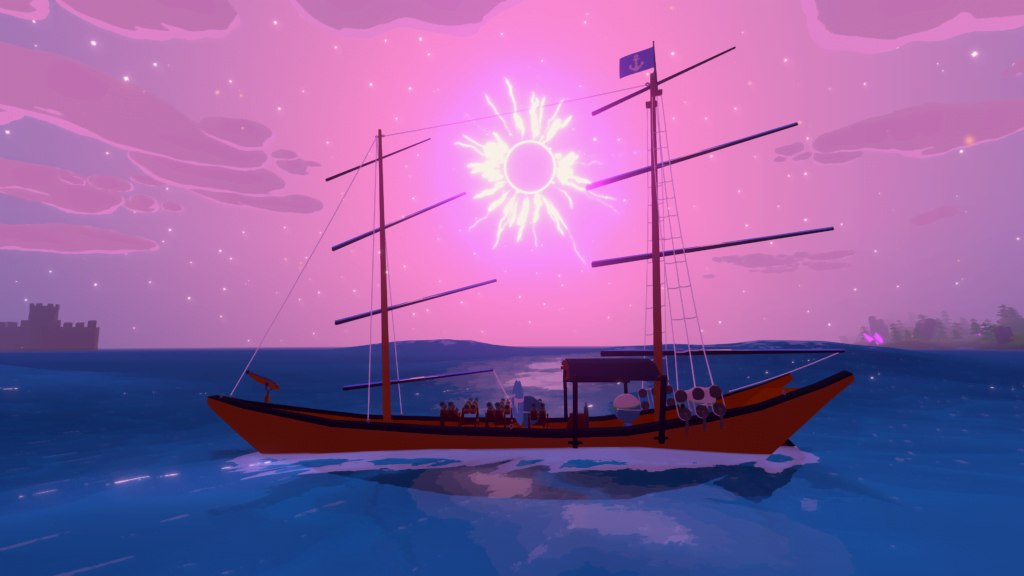
Sail Forth
Sail Forth has been out since last year, but an expansion is due to be out soon, so I took it as a chance to give Sail Forth a proper go. Don’t know how I missed it before: seems very cool.
Sail Forth was pitched to me as a Legend of Zelda: Wind Waker inspired adventure. You play as the captain of a ship and sail the seas fighting fellow pirates and the occasional fortress on land, taking on quests and generally exploring the world. The coming expansion sees you head into a different world, a sort of mirrored version but with a lot of changes.
The brief peek I got at it started with a descent into a whirlpool that led to another ocean. It didn’t seem too different at first glance apart from the red sky, but I also didn’t see a whole lot either. Most I was able to do was free some people who were trapped on an island where turrets had been built before the demo came to a close. The pitch I got was that you would be investigating what’s going on in this side of the ocean, the characters hinting at some weird phenomena happening around here.
As a general look at Sail Forth, though, I quite liked it. It’s a very easygoing game. Drifting along the ocean poking around at islands definitely captures some of the appeals of doing the same in Wind Waker.

Rabbit and Steel
Rabbit and Steel is all about raids. It’s effectively an attempt to remove the long treadmill of prep that’s part and parcel so you can just get to the good stuff. I’ve never actually played any sort of “raid” before Rabbit and Steel (MMOs aren’t for me), but I see the appeal.
You and three other players select one of five classes (at least in the demo; more are planned for the final version), each with different play styles. The one I chose was a more close-range one wielding a large sword. She wasn’t the most powerful at a distance, but the sword strikes make up for it. Each of the abilities are mapped to the face buttons and go on a cooldown once used.
Stages are a series of boss fights. They’re pretty straightforward on the surface, but require some quick and attentive teamwork to beat. Throughout the fights you’re given instructions to follow to avoid their big attacks. You might need to spread out or stay close to one another, maybe follow an orb that moves about the screen to stay safe or try to lead the projected attack path in different directions to keep them away from you. It’s a very busy game, visually, but somehow still legible at all times. I never felt lost. I always had a good idea of what I should be doing and why. Didn’t stop me from dying a couple of times still, but at least I wasn’t totally useless!
A full run generally takes around 15 minutes, which is very fast based on what I’ve heard about traditional MMO raids. The game has local and online play. I’m not sure whether active communication will be needed or not (everyone I watched play seemed to have gotten by without chatting much), but the fact that the game is clear in communicating what you need to be doing should be enough, I hope.

Parry Nightmare
Parry Nightmare is about holding back a never-ending tide of monsters by using their attacks against them. You play as a tired-looking spirit who is joined by Honno, a small horned girl who represents your will to live. She’s also the muscle here. Parrying attacks alone isn’t enough to vanquish foes. They merely clear the way for Honno to deal the final blow while also creating space for you to move. You do still need to protect her, however, as she can get knocked out, requiring you to run over to where she lands.
It gets very, very overwhelming quickly. The number of foes eventually reaches a point where you can’t see the ground anymore, your immediate vicinity literally the only space free of enemies or projectiles. Every attempt I made ended just short of the goal I needed to hit. On one hand, it spoke to how well I did. On the other, I can’t imagine how much more difficult later levels could become if this is just a sample.
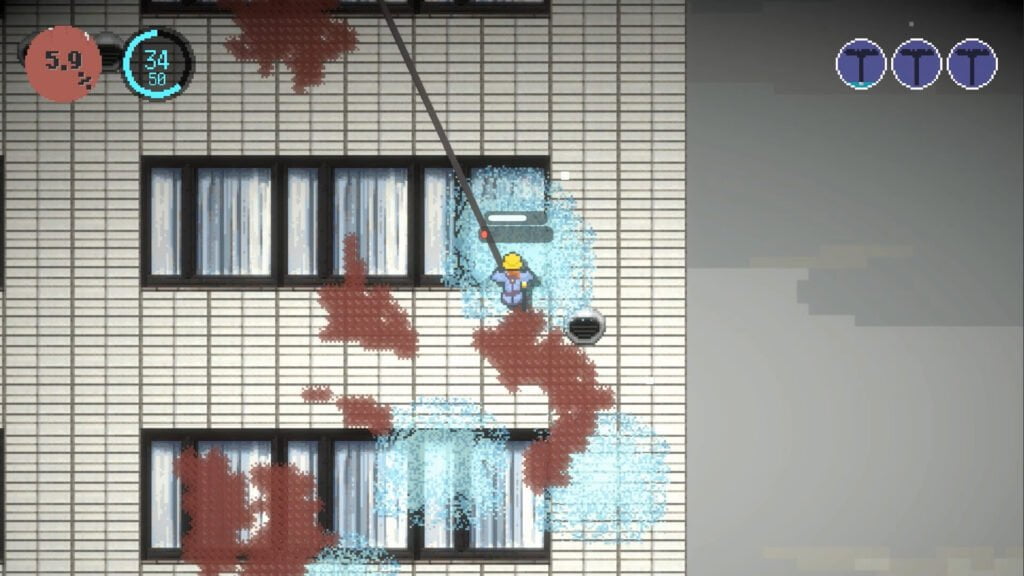
Sky the Scraper
When I saw the pitch on Sky the Scraper, I figured it was just going to be an arcade style game about cleaning buildings. Then I played it and found there’s a whole other stat management layer too.
Sky the Scraper follows Sky, someone who’s just struck out on their own and gotten a job cleaning buildings. Immediately you need to scrape up enough cash to cover the deposit on your apartment. You have a week to get that done. The problem: you only work so many days and your performance decides how much you’re bringing home. If you’re not careful and get injured on the job, that’s multiple days of work you’ll miss out on.
The actual job consists of 60-second shifts where you try to clean as much as you possibly can before time expires. You have a grip meter that dictates how long you can hold onto the building and scrub the gunk off. It depletes quickly, but Sky can also move just as fast, so it’s only really a problem if you aren’t paying close attention. First couple shifts went off without a hitch, as such.
Wasn’t until birds started flying in front of me that I ran into trouble. First time they appeared, I suddenly fell off the building and wasn’t sure what happened. Lost a couple days of work, which sucked. Couldn’t do anything but rest. Was determined to be more careful next time so it wouldn’t happen again. But again, those damn birds got me, and again I lost days of work. I tried to make up for lost time, but I still came in short on the deposit.

Nyaaaanvy
It’s like Gang Beasts but you’re playing as a bunch of very long and noodle-like cats. That’s perhaps a bit reductive, but it captures the broad strokes. It’s a local multiplayer game that is incredibly silly. Up to four players fight to knock each other out off the stage by flopping about. You attack by swinging the right stick or using the face buttons to attack in the direction you want. Last one standing wins. Cute game! Very fun. Seems like another local multiplayer hit.

Metal Bringer
The first time I got to the action in Metal Bringer, I was immediately beset by a massive, seemingly never ending horde of enemies. I tried to fight my way through them, but they’re numbers proved too much. I was doomed from the start. When I got back to base, I started trying to figure out how I could change my build to give myself a better shot.
Metal Bringer is an action roguelike all about customizing your character. There’s the cosmetic aspect, of course, but the draw mainly seems to be the sheer amount of depth you can go into regarding stats and weapons. There’s a lot going on. You can choose from a massive arsenal of melee and ranged weapons and can then enhance your adeptness at using certain weapons specifically using mods. I don’t know how that works, exactly (didn’t get a tutorial in the demo), but I know I got a lot of them.
I made a few runs, but I didn’t ever get very far. The enemies immediately swarm you from the word go, giving you almost no room to breathe or get your bearings. I could fight through them well enough, but doing so well enough to actually press forward was another matter. It feels like something I just needed a lot more time to dive into to better understand all the systems at play.

Survivor Mercs
Somehow I’ve not played any of the “bullet heaven” style games until Survivor Mercs. Vampire Survivors and the countless games it’s spawned have passed me by until now. Having finally played one: I get it.
Survivor Mercs, which launched in Early Access recently, is pretty straightforward. Each run you choose a mercenary to accompany you at the start. As the run progresses, you get the opportunity to recruit more and upgrade their abilities. They circle around you firing at anything they see. For the first couple of minutes, enemy numbers are small and manageable. Once you’re a few minutes in, the intensity increases, but so too does the firepower you’re walking around with, ideally.
The goal is to collect as many diamonds as possible and extract them safely. Not a terribly difficult task given the advantage you have, but moving around the field does become trickier as the enemy numbers increase. I eventually needed to slow down a bit to ensure I had a path forward rather than keep pressing on unabated. It never became enough of a problem to put me in peril, but it did start to feel close to being too much at a certain point.
If you spend ten minutes or more on a run, eventually a boss will spawn. You get greater rewards if you can take them down, but by that point you’ve also likely gathered so many diamonds that you probably want to be cautious. I ended my first run before they arrived, but on my second I took them on. A lot was going on, so I don’t quite remember the specifics (was too focused on not dying), but I did take them down. I immediately ended the run afterward.

PixelJunk Scrapper
I can tell I’m out of the loop regarding PixelJunk because I had no idea PixelJunk Scrapper was released this past month. Scrapper is a side-scrolling brawler for up to four players wherein you play as garbage collector robots. You choose a character, each with a different default weapon (I went with a pair of daggers) and go to work.
It’s pretty straightforward as far as brawlers go. I mostly just mashed the attack button and got by just fine. You can pick up garbage or downed foes and throw them to knock down other enemies, or you can just toss them all into the dump truck instead. The more trash you pick up, the higher the reward when it’s thrown into the truck, but it also becomes harder to carry. It becomes a stack that tilts as you move, requiring a bit of finesse to dispose of. Teamwork came into play more here because you’re vulnerable when carrying garbage. Protecting one another to ensure the trash ends up in the truck is a good way to keep the moment to moment action engaging.
There’s also some competitive modes too. The one I played saw me and the two devs I played with all trying to see who could get the highest score from tossing trash and enemies into the dump truck. It became very silly very fast.

PixelJunk Eden 2
My main takeaway from playing PixelJunk Eden 2 was that I should finally play that copy of PixelJunk Eden I’ve had forever. PixelJunk Eden is a zen sort of platformer. You play as a “grimp” and navigate levels by jumping and swinging using vines you can attach to plants. It’s momentum-based but with a touch of floaty physics at work, which is fine here given the lightweight nature of your character.
The objective is to collect seeds and plant them at certain points to create more plants you can jump to and swing from. It almost feels like tending a garden. Each level comes alive as more and more plants sprout, slowly leading you to the exit. Even amid the loud and busy show floor of PAX, the meditative qualities still came through. It’s not a challenging game, but a very pleasant one.
The sequel seems to be more of the last game generally, but there are some additions. For one, there are different characters you can play as, each with their own abilities that can help make certain levels easier. But really, even if it was just literally more PixelJunk Eden and nothing else, that’s not a bad thing.

Enotria: The Last Song
Souls-likes are a genre that is of special interest to me because I really, really like the particular style of play they deal in. What sets Enotria: The Last Song apart is, one, it’s based on Italian folklore, which is a unique setting compared to the usual dark fantasy flair that’s so common, and two, masks.
Masks act as a way to change your loadout on the fly. In the demo, one mask was equipped with heavy weapons — a greatsword and a hammer — while the other had a couple of lighter swords to swap between. I stuck with the latter since heavy weapons aren’t my style. Much prefer to be quick. Enotria is more on the deliberate side of Souls-likes in terms of speed, though. Every swing has significant startup and recovery, the characters moving at a languid pace. This is not a fast-paced action game like the genre and FromSoft’s own work has begun to trend toward, but the classic slower pace of play that defined this genre in its early days.
It is, however, focused on evasion and parries for defense. Blocking is not an option. You have to dodge or parry if you want to avoid taking damage. Because the enemies as well have long startup on their attacks, avoiding them is easy. Baiting attacks and punishing their recovery seemed to be the play. The parry timing feels… I don’t want to say lenient, but it didn’t feel as tight as I worried it would be. I didn’t have a perfect success rate or anything, but I was able to deflect strikes with a greater consistency than I thought.
It’s important because parries do eventually put the enemy in a downed state that lets you deliver a powerful blow. This was very helpful against the boss I encountered. Its large swings made it difficult to find a space I could safely strike from, so deflections were key in making progress. Though even that wasn’t really enough, as I’d still receive some small damage depending on how on-point my parries were. If I timed it right, the damage was basically nothing. If I was off, it would be less than taking the hit outright, but enough to be a problem if I weren’t careful. Crucially, though, the parries often still seemed to work even as I took more damage. Seems like a case where they’re useful to get an edge but not essential.

Demonschool
At a glance, Demonschool looks inspired by Persona — the first two, specifically. It’s an RPG following a bunch of students investigating supernatural happenings around them. The comparisons naturally follow. In execution, however, those comparisons feel much more coincidental than intentional.
The demo I played had a couple of different scenarios. I chose the one with a stronger story focus because I didn’t want to jump straight into a boss fight without being familiar with the combat first. The scenario opened with the group retrieving footage from a camera they set up to try catching evidence of some arcane ritual happening. Before they can do that, the local gang walks in, demons in tow and a fight begins.
Demonschool is a tactical RPG. Combat is built purely around movement and positioning. You don’t command your party directly, but merely plan their movements. When you reach a square occupied by an enemy, the character will automatically attack. You have a set number of action points you can spend per turn that’s shared between the whole party. No one’s limited to a single action, but having any one character take multiple actions does increase the cost with each new move. The sole exception is side-stepping, which never has a cost.
The idea is to position your party to set up combos. Knocking one enemy into another character who can attack will make them attack, which does more damage. If you screw up while planning, you can rewind at no cost. Learning how to make the most of my party’s abilities while trying to exploit enemy weaknesses definitely pushed me to think carefully about positioning and how best to make the most of each turn. That I didn’t have to actually give commands was a bit of a surprise, but it does make it easier to focus on the strategy layer.
After the fight, the rest of the demo largely saw me running around town investigating leads and checking in with the party. Some of it was following up on some side quests that presumably had been done prior to where the demo began, while others were just fun interstitial scenes between the party. The writing was good from what I saw. The cast is a fun bunch to follow around.
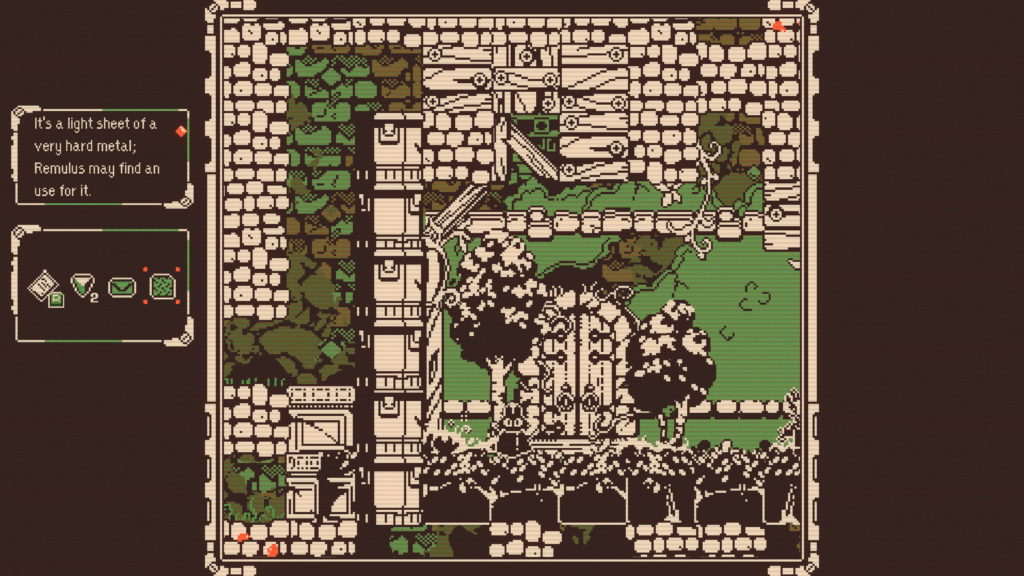
Everdeep Aurora
Everdeep Aurora gave me some Downwell vibes in terms of its presentation. The game is displayed primarily in a box in the center of the screen, the left and right sides reserved for info like your map and inventory. As Shell, an adorable little cat, you’re drilling into the earth to reach a place of sanctuary to escape a coming disaster on the surface and to reunite with her mother who disappeared, leaving only a note with where to find her.
The drill you use has limited energy. You can’t just drill constantly, but rather have to conserve the energy as best you can. I waited for the drill to cool off before starting it up again – which doesn’t take any time at all – to help keep the drill at max energy. The first segment of the bar starts to fade as you use the drill, but returns to its usual full state if given a moment of rest before that segment is spent, so I took that as a sign to be a bit patient.
As you dive deeper into the earth, you meet with fellow travelers and denizens of the underground. I found a smith who could help strengthen my drill, but I needed a particular kind of stone to do it. I tried finding one, but it must have been hidden much further down. If so, returning to him would be a problem as I wasn’t quite sure how best to ascend. Shell can wall jump to get some extra air time, which helps with making traversal and ascent easier, but unless I was carving a path in a very particular way, I wasn’t often able to climb back up very far. I imagine there’s some ability I just didn’t find.

World of Horror
The first thing to catch anyone’s eye about World of Horror is the incredible art. The “1-bit” style is clearly inspired by Junji Ito and was remarkably made entirely within MS Paint. It’s a menu-based adventure game/RPG where you play through different scenarios, each with their own protagonist and monster to banish. The broader story involves an event that’s about to bring about the end of the world, which is why there are monsters roaming about. Your job is to get rid of them and hopefully avert the coming apocalypse.
World of Horror has been in Early Access on Steam for a while now, so the demo I played was a peek at the 1.0 release out next month. The PlayStation 4 version was demoed and it largely seems to have made the jump to console well. Only point of friction is moving the cursor around. Moving the cursor around quickly was slightly unintuitive in that I had to push both analog sticks in the direction I wanted rather than just control the tilt on the left stick to control its speed. Got the hang of it quickly enough, though it definitely is an unorthodox approach.
I played one scenario set in a school haunted by a spirit who has a particular fascination with scissors and cutting people up with them, as that’s what the game recommends for a first-time player. What I had to do was prepare for a ritual to seal the spirit. I didn’t have the necessary supplies, however, so I needed to scour the school in search of them.
Eventually I ran into a couple of fights. Combat involves queuing actions, each with a different cost, and then seeing how the turn plays out. I barely made it through the first fight (foolishly tried to just brute force it rather than try adding some defensive actions in) and got farther than I expected in the second, but inevitably met my end at the hands of the spirit I was after. Game seems hard. Impeccable vibes, though.

Rift of the Necrodancer
After blending roguelike dungeon crawling with rhythm gameplay, the newest Necrodancer game takes things in a much different direction. Rift of the Necrodancer is a mix of Rhythm Heaven-style minigames and traditional note highways. It has a greater focus on just playing along with the music instead of being more involved like Crypt of the Necrodancer or Cadence of Hyrule was.
The demo I played took me through a bunch of different scenarios. The first was a confrontation of sorts that was played out via hitting notes moving down a track. Cadence sits on the left side of the screen, while a hooded figure stands on the right, both bobbing to the beat and reacting to the action. Classic rhythm game stuff. First song was pretty easy – a remix of the classic Disco Descent from Crypt of the Necrodancer – but the second – a new song – was tough. Mainly because it introduced a lot more different note behaviors and was longer track than the first. Had to drop the difficulty down to easy lest I spent the entire time I had to play just on that one song.
Next was a scene of a yoga session where Cadence and the other attendees had to follow the instructor’s lead. This was the most Rhythm Heaven-esque part of the demo, even down to the art. Finally the demo ended with a duel of sorts. Notes would approach from the left and right, each needing to be avoided in time with the beat. If Cadence doesn’t get hit, the opponent comes forward and allows you to attack.
The variety on display is fun and inventive, the music underscoring each scene excellent and very catchy. If the Necrodancer games become a proper series, switching up the kind of game it is feels like the right move. Or if this is just a one-off instead, then it’s at least a fun change from the previous game.

Cobalt Core
I said earlier I’m not usually one for card games, but there is an exception: roguelikes. Slay the Spire was my entry point and though I don’t play roguelike deckbuilders often, I do enjoy them. They’re easier for me to wrap my head around since the deck comes together during a run instead of having to make and maintain one long term. Less intimidating.
Cobalt Core is a roguelike deckbuilder where you pilot a ship whose crew is trapped in a time loop. It’s story is one that unfolds over time, both through failed and completed runs sort of like Hades, which is an exciting prospect given how a narrative hook can help keep things interesting even in the face of constant failure. Your starting deck is determined by the crew. Who you bring along grants access to different types of cards, which, along with the ship, creates a lot of potential ways to plan out a run and see how it plays out.
The demo wasted no time in throwing me into a fight. Combat is turn-based. You have a set number of action points you can spend, with each card costing a certain number of those points to play. You can also move your ship left and right to dodge attacks. Movement isn’t tied to the same pool you draw from to play cards, but it is limited as well. Positioning is important because you can also use it to aim your shots at more vulnerable parts of the enemy ship. It adds an extra layer of strategy that gives Cobalt Core a good hook.
I didn’t do particularly well, though. I got through the first fight okay, but the second proved to be a much greater challenge. I scraped by, but I lost so many hit-points that I knew I wasn’t going to last long if I ran into another enemy. I wanted to give it another shot, which is always a good sign as far as roguelikes go.

